Raspberry Point Oysters
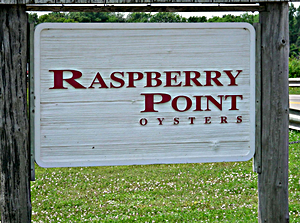 On the Northern coast of Prince Edward Island (PEI), the hills are covered in a patchwork of bushy green potato plants sprouting their white flowers alternating with squares of brilliant golden fields of swaying canola. We drove on Route 6 over Stanley Bridge spanning an inlet of the Stanley River off of the New London Bay which was striped with straight rows of colored buoys. The driveway leading down to the river was marked by a sign reading “Raspberry Point Oysters.” Our Aunt Karen and Uncle Stephen told us that Raspberry Point produces some of the island’s (as well as the country’s) finest oysters.
On the Northern coast of Prince Edward Island (PEI), the hills are covered in a patchwork of bushy green potato plants sprouting their white flowers alternating with squares of brilliant golden fields of swaying canola. We drove on Route 6 over Stanley Bridge spanning an inlet of the Stanley River off of the New London Bay which was striped with straight rows of colored buoys. The driveway leading down to the river was marked by a sign reading “Raspberry Point Oysters.” Our Aunt Karen and Uncle Stephen told us that Raspberry Point produces some of the island’s (as well as the country’s) finest oysters.
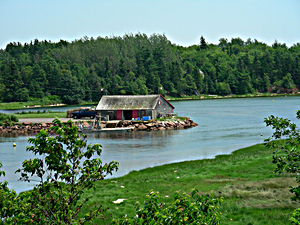 Amanda immediately recognized the name “Raspberry Point” from working at Union Square Cafe in New York City where they serve Raspberry Points. Taking a chance that they would be open, Stephen turned the car down the gravel road toward the small oyster hut jutting out into the lake.
Amanda immediately recognized the name “Raspberry Point” from working at Union Square Cafe in New York City where they serve Raspberry Points. Taking a chance that they would be open, Stephen turned the car down the gravel road toward the small oyster hut jutting out into the lake.
High stacks of oyster crates full of just-harvested oysters stood in front of the hut. Inside, two men stood in waders scrubbing and spraying oysters on a small conveyor. We introduced ourselves and one of the men came out of the shack to shake our hands, talk about his oysters, and give us a taste of his incredible catch.
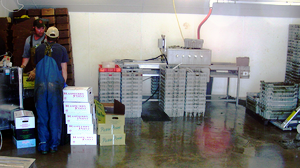 It turned out that the man’s name was James Powell, a PEI native and owner of Raspberry Point Oysters. With oyster knife in one hand and an oyster in the other gloved hand, he began shucking oysters for us to taste, tossing the shells over his shoulder into the side of the road. My first oyster had a distinct mossy flavor and a mild brininess followed by a very sweet taste.
It turned out that the man’s name was James Powell, a PEI native and owner of Raspberry Point Oysters. With oyster knife in one hand and an oyster in the other gloved hand, he began shucking oysters for us to taste, tossing the shells over his shoulder into the side of the road. My first oyster had a distinct mossy flavor and a mild brininess followed by a very sweet taste.
As he continued to shuck and hand us oysters, he began talking to us about the oyster business: raising them, their flavor, the environment in which they thrive. He popped the top of the oyster, chucked it to the side, and carefully loosened the oyster from its shell by scraping the muscle. “These oysters here were growing in eel grass, that is probably what you are tasting,” he replied when asked about the mossy flavor of my first oyster.
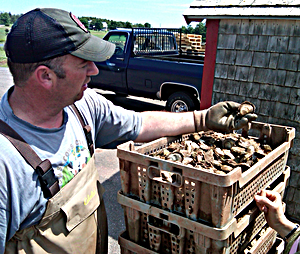 My second oyster had a sharp brininess with almost none of the mossy “green” flavor and Raspberry Point’s signature sweetness coming forward at the end. James pointed to the muscle with which the oyster attaches itself to the inside of the shell: “This is where the sweetness is, that is why you get the sweetness at the end, as you chew.” James also correctly pointed out that Raspberry Point oysters have a distinct and complex sea-salt flavor, whereas some oysters have more of a flat, table-salt flavor.
My second oyster had a sharp brininess with almost none of the mossy “green” flavor and Raspberry Point’s signature sweetness coming forward at the end. James pointed to the muscle with which the oyster attaches itself to the inside of the shell: “This is where the sweetness is, that is why you get the sweetness at the end, as you chew.” James also correctly pointed out that Raspberry Point oysters have a distinct and complex sea-salt flavor, whereas some oysters have more of a flat, table-salt flavor.
“It seems that the flavor varies a lot from oyster to oyster,” we suggested, “Absolutely,” James agreed, “oysters are like little people, each one is unique!”
Raspberry Point has a very gentle tide which is an important factor in growing oysters. When you put an oyster into a strong current, as the oyster releases calcium to form the shell, it will grow long and narrow with the current which is not the ideal shape for an oyster. A gentle current creates a more desirable, rounded oyster.
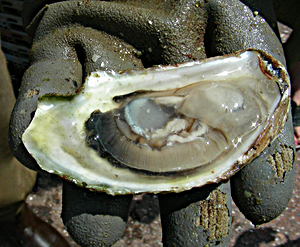 Oyster harvesting takes place year-round except during the spring spawning season which occurs during March and April. Allowing this time for the oysters to spawn, ensures a healthy future for the oysters, making oyster farming a sustainable fishing practice.
Oyster harvesting takes place year-round except during the spring spawning season which occurs during March and April. Allowing this time for the oysters to spawn, ensures a healthy future for the oysters, making oyster farming a sustainable fishing practice.
After oysters reproduce, they immediately swim to a place where they can attach themselves for life. Oyster farmers provide a happy place for oysters to live by applying a paper-thin coating of concrete to a large plastic cone which is then submerged in water and marked with a buoy.
“We try to give each oyster about this much room to grow,” said James, making a ten-inch circle of oyster-sized real estate with his hands. This space allows each oyster enough room to feed and grow to its greatest potential.
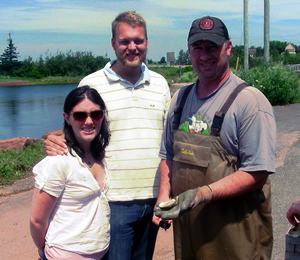 The oysters that are sold out of Raspberry Point all measure up to a high specification standard. The farmer visually measures the oysters to fit a length-to-width ratio of roughly 3-to-2. The oysters also need to be a certain size, “Many people nowadays like the cocktail-sized oysters,” James said of the smaller oysters that he sells, but the most prized among locals and fishermen are the large, palm-sized oysters that take six-to-seven years to develop.
The oysters that are sold out of Raspberry Point all measure up to a high specification standard. The farmer visually measures the oysters to fit a length-to-width ratio of roughly 3-to-2. The oysters also need to be a certain size, “Many people nowadays like the cocktail-sized oysters,” James said of the smaller oysters that he sells, but the most prized among locals and fishermen are the large, palm-sized oysters that take six-to-seven years to develop.
James showed us how to tell the age of an oyster by counting the rings, a process much like counting the rings on a tree. The first year of growth starts near the tip of the oyster and is as small as a pinkie nail. From there, the rings of annual growth can be seen as concentric circles of increasingly wider berths.
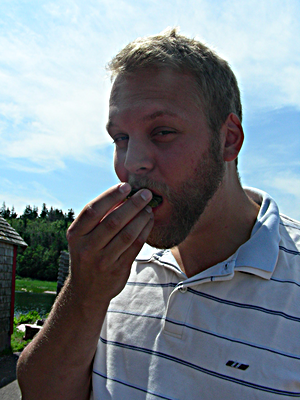 Diners and restaurant workers around the country have opened and tasted Raspberry Point oysters and admired their superb quality and unique flavor, but to go to the place where they are grown, smell the ocean air, and meet the fishermen is a comprehensive experience that can only be had on Prince Edward Island!
Diners and restaurant workers around the country have opened and tasted Raspberry Point oysters and admired their superb quality and unique flavor, but to go to the place where they are grown, smell the ocean air, and meet the fishermen is a comprehensive experience that can only be had on Prince Edward Island!


What a clever post! Your meeting with James was fascinating. I had no idea about any of that oyster stuff.
Enjoy the PEI. I look forward to reading more.